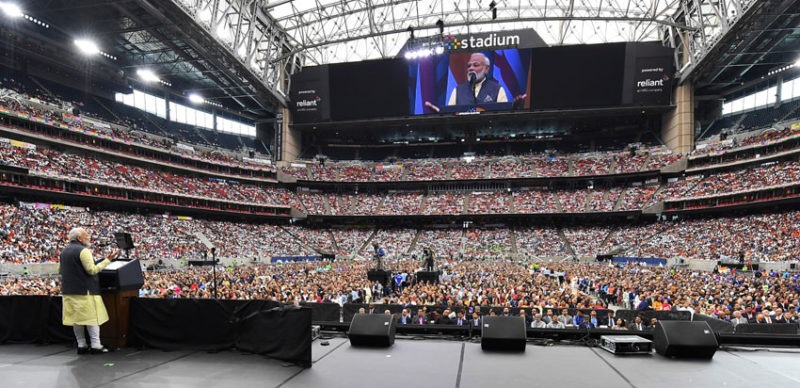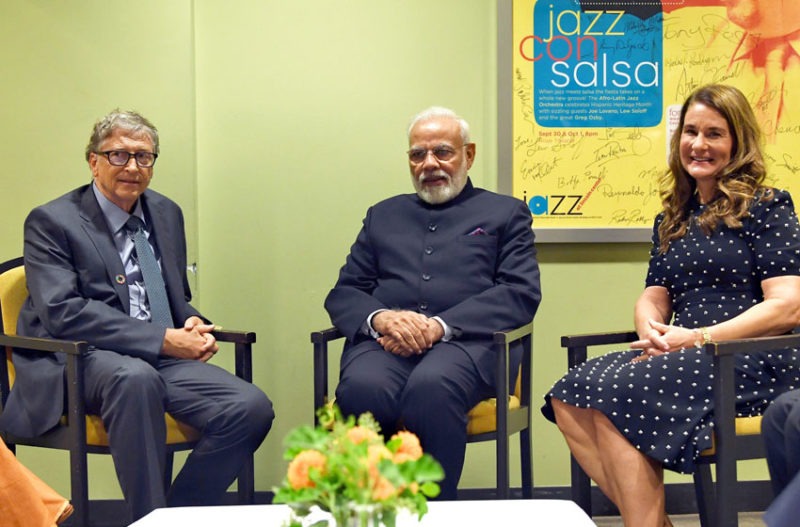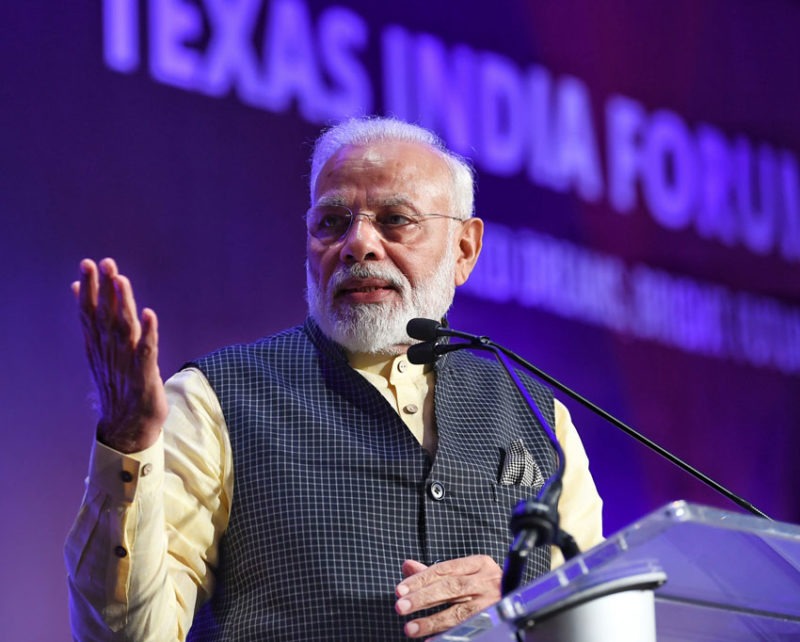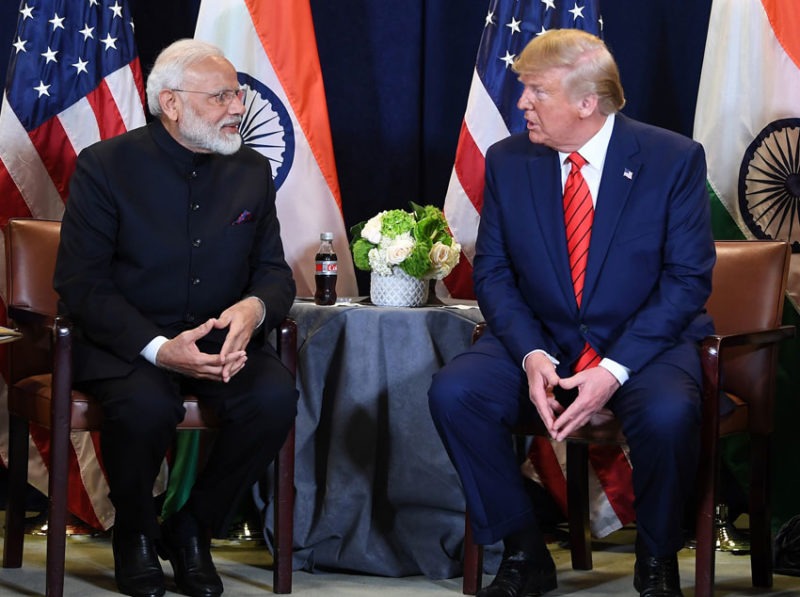Howdy Modi: Indian Prime Minister Narendra Modi Aces Diaspora Diplomacy in Houston
Indian Prime Minister Narendra Modi addressing at the ‘Howdy Modi’ event, in Houston, Texas, Sept. 22. (PIB)
The magnificent, sprawling NRG Football stadium in Houston, Texas, saw history in the making on Sept. 22, 2019.
The President of the United States of America, the world’s strongest democracy, Donald Trump, and Prime Minister of the largest democracy, India, Narendra Modi, graced the three-hour-long “Howdy Modi” event with clasped hands, greeting a gathering of more than fifty thousand Indian Americans who were chanting “Modi, Modi!”
The global audience, especially back home in India, marveled at the mass of humongous support that turned out for Modi, following word to word, the marathon speeches of the two most popular leaders of the world on “Shared Dreams, Bright Futures.”

The spectacular interaction, bigger than the 2014 Madison Square Garden and 2015 San Jose events, earlier addressed by Modi, overtook past events for any foreign leader on American soil, other than the Pope, and was the first for an American President to share the stage with a visiting leader at a diaspora event.
Undeniably, as an appreciation of the rapid progress in influence of the wealthy, talented, professionally astute and powerful Indian diaspora, firmly aided with the adept outreach of the Indian embassy in the U.S. to the Senate and House of Representatives, Trump’s impressive lineup included twenty-four U.S. lawmakers, prominent ones being Senator Ted Cruz, Senator Cornyn, Democratic House Majority Leader Steny Hoyer and a Governor, all of whom sat through more than an hour long address of Modi.
If not for the potential of winning voters from amongst traditional Democratic supporters that defines the Indian Americans, perhaps the story of U.S. participation would have been an altogether different chapter.
And as per a White House communiqué, accompanying Modi was a 13-member delegation including External Affairs Minister S. Jaishankar, Commerce Minister Piyush Goyal, Foreign Secretary Vijay Gokhale and Indian Ambassador to the U.S., Harsh Shringla.

On a seven day tour, when he enplaned in the energy capital of the world, Houston, Modi first met the CEOs of sixteen firms, comprising Baker Hughes, Cheniere Energy, Exxonmobil, Lyondellbasell Industries, Schlumberger and Tellurian Inc. and oversaw the closing of a hydrocarbon deal between India’s state run Petronet and U.S. developer Tellurian Inc’s Driftwood project in Louisiana.

Thereafter, the “Howdy Modi” event marked the grand display of Modi’s trademark showmanship, as he infused energy and visibility to his recounting of Indo-U.S. closeness, his administration’s successes, cleverly cutting down Pakistan to size while lavishing profuse praises on Trump and obliquely suggesting a tacit endorsement of his re-election as well as raising anticipation for the long awaited partial trade treaty, considered a precursor to a comprehensive bilateral one.
However, U.S.’s enthusiastic political support to New Delhi as evident in its refrain from intervention in Kashmir issue, delisting of terrorist chief Masood Azhar, expression of faith in Modi’s leadership in “keeping everyone together like a father” and tackling its cross border security and terror issues, even as Trump remained noncommittal in leading that anti-terror battle in South Asia, convergence over issues related to the Indo-Pacific, and the bonhomie between the two leaders at the Houston event, could not set the platform to navigate rough waters of trade negotiations.
Trade deals have never been easy and once again distances could not be covered and government sources attributed it to lack of reciprocity and asymmetrical demands of the U.S. negotiators in allowing any forward movement.

According to analysts, the U.S. refused benefits to Indian exporters under the Generalized System of Preferences unless New Delhi conceded to market access to U.S. dairy and medical services sector, reduce exorbitant retaliatory tariffs on apple exports from Washington state and almond exports from California, accommodate demands of technology giants to store data locally, and allow e-commerce firms to sell products on platforms they have a stake in in India, or that India reduces its trade surplus among a sundry more demands.
Though the success in the closing of the partial trade agreement held electoral advantages to Trump, the high bar of U.S. demands prevented Modi from giving away to too much in view of his own voters’ base and the apparent slowing down of the Indian economy.


Hence real outcomes lay in discussions on defence and security cooperation and other engagements, prominent ones amongst those being, Modi’s attendance of the Leaders’ Dialogue on “Strategic Responses to Terrorist & Violent Extremist Narratives”, meetings with bilateral and multilateral partners, Bloomberg Global Business Forum in which he pitched for India as the key destination in investment and trade and for its entry in Nuclear Suppliers’ Group for access to nuclear fuel, CAIRCOM Summit, and the yet to take place, his second address at the United Nations General Assembly session.
Notably Modi’s participation in the UN’s Climate Change Summit was unique as it followed with his inauguration of the Gandhi Solar Park at the UN Headquarters to commemorate 150 years of the birth of peace apostle, Mahatma Gandhi, and signing of an agreement for planting of 150 trees in 600 acre campus of the State University of Westbury.


The focal point that emerges from Modi’s high voltage engagement with the U.S. on the latter’s soil is his administration’s adherence to view the U.S. as the most indispensable global partner in the realizing of India’s ambitions of becoming a $5 trillion economy as much as in supporting its domestic and political moves vis a vis its recalcitrant neighbors, China and Pakistan.
In strict compliance with this agenda the past six years have witnessed New Delhi actively courting of new friends – Israel, Japan and UAE, all of whom share strong U.S. ties.
And to this end Modi’s deft employment of diaspora diplomacy has been a shot in the arm to the cause of re-strengthening of Indo-U.S. partnership.




